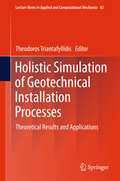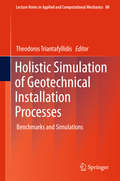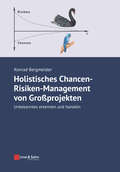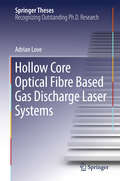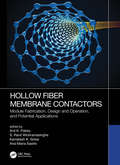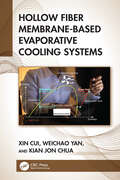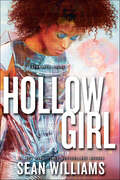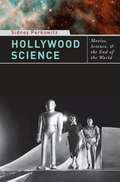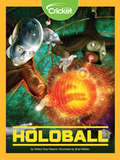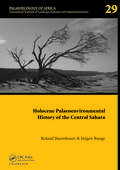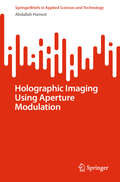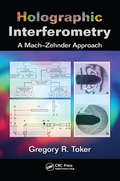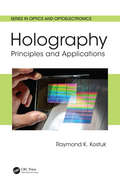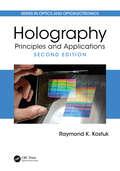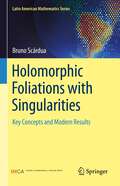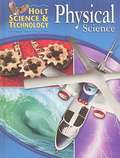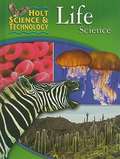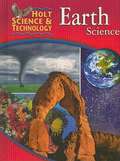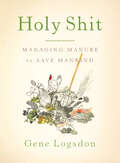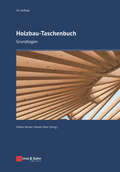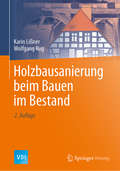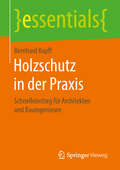- Table View
- List View
Holistic Simulation of Geotechnical Installation Processes
by Theodoros TriantafyllidisThis book examines in detail the entire process involved in implementing geotechnical projects, from a well-defined initial stress and deformation state, to the completion of the installation process. The individual chapters provide the fundamental knowledge needed to effectively improve soil-structure interaction models. Further, they present the results of theoretical fundamental research on suitable constitutive models, contact formulations, and efficient numerical implementations and algorithms. Applications of fundamental research on boundary value problems are also considered in order to improve the implementation of the theoretical models developed. Subsequent chapters highlight parametric studies of the respective geotechnical installation process, as well as elementary and large-scale model tests under well-defined conditions, in order to identify the most essential parameters for optimizing the process. The book provides suitable methods for simulating boundary value problems in connection with geotechnical installation processes, offering reliable predictions for the deformation behavior of structures in static contexts or dynamic interaction with the soil.
Holistic Simulation of Geotechnical Installation Processes
by Theodoros TriantafyllidisThis book examines in detail the entire process involved in implementing geotechnical projects, from a well-defined initial stress and deformation state, to the completion of the installation process. The individual chapters provide the fundamental knowledge needed to effectively improve soil-structure interaction models. Further, they present the results of theoretical fundamental research on suitable constitutive models, contact formulations, and efficient numerical implementations and algorithms. Applications of fundamental research on boundary value problems are also considered in order to improve the implementation of the theoretical models developed. Subsequent chapters highlight parametric studies of the respective geotechnical installation process, as well as elementary and large-scale model tests under well-defined conditions, in order to identify the most essential parameters for optimizing the process. The book provides suitable methods for simulating boundary value problems in connection with geotechnical installation processes, offering reliable predictions for the deformation behavior of structures in static contexts or dynamic interaction with the soil.
Holistisches Chancen-Risiken-Management von Grossprojekten: Unbekanntes erkennen und handeln
by Konrad BergmeisterExtreme Ereignisse sind in unserem Denken meist weit weg entfernt. Treten sie trotzdem ein, treffen sie uns oft unerwartet. Wenn Ereignisse mit schweren Folgen für die Umwelt und den Menschen einzeln auftreten, werden sie von den meisten Menschen als extrem empfunden. Eine Vielzahl von kleineren Ereignissen über einen längeren Zeitraum, deren Wirkung in Summe ähnlich groß ist, kümmern hingegen kaum jemanden. Gerade bei großen Bauprojekten verursacht das Eintreten von nicht erwarteten, extremen Ereignissen wie Naturgefahren, der Einsturz einer Brücke oder der Brand in einem Tunnel oft eine auch öffentlich wahrgenommene Schockwirkung. Aber auch die Überschreitung von Kosten und Bauzeiten, bedingt durch unbekannte Risiken, verursachen Ängste und Schuldzuweisungen.Das Buch zeigt einen möglichen Weg auf, wie solchen unbekannten Risiken aber auch Chancen begegnet werden kann. Basierend auf wissenschaftlichen Grundlagen und umfangreichen prak-tischen Erfahrungen wird ein strukturiertes holistisches Chancen-Risiken-Management für Großprojekte erläutert. Auch auf die Corona-Thematik wird aus Sicht des Chancen-Risiken- Managements eingegangen.
Hollow Core Optical Fibre Based Gas Discharge Laser Systems (Springer Theses)
by Adrian LoveThe research in this book represents the culmination of a drive to build the first discharge gas laser unencumbered by the effects of diffraction. This breakthrough has been achieved through careful implementation of a discharge within a hollow-core optical fibre, and by developing measurement and analysis techniques to demonstrate laser action in an experimental optical cavity. Gas lasers were amongst the earliest laser types to be demonstrated and commercialised, but it was recognised that noble gas lasers were limited by the minimum bore diameter of the laser tube, which is set by diffraction. The advent, in 2011, of hollow optical fibres with optical and physical properties suitable for gas discharge lasers opened up the opportunity to break this diffraction limit. Using a mixture of helium and xenon gas, lasing in the mid-infrared range was achieved using a 100µm core flexible hollow optical fibre which, at 1m long, is several hundred times the diffraction-limited Rayleigh length.
Hollow Fiber Membrane Contactors: Module Fabrication, Design and Operation, and Potential Applications
by Anil K. Pabby, S. Ranil Wickramasinghe, Kamalesh K. Sirkar, Ana-Maria SastreThis book on hollow fiber contractors presents an up-to-date compilation of the latest developments and milestones in this membrane technology. Hollow Fiber Membrane Contactors: Module Fabrication, Design and Operation, and Potential Applications provides a comprehensive discussion of hollow fiber membrane applications (including a few case studies) in biotechnology, chemical, food, and nuclear engineering. The chapters in this book have been classified using the following, based on different ways of contacting fluids with each other: Gas-liquid contacting; Liquid-liquid contacting; Supported liquid membrane; Supported gas membrane; Fluid-fluid contacting. Other features include: Discusses using non-dispersive solvent extraction, hollow fiber strip dispersion, hollow fiber supported liquid membranes and role of process intensification in integrated use of these processes Provides technical and economic perspectives with several case studies related to specific scenarios Demonstrates module fabrication, design, operation and maintenance of hollow fiber contactors for different applications and performance Presents discussion on newer concepts like membrane emulsification, membrane nanoprecipitation, membrane crystallization and membrane condenser Special focus on emerging areas such as the use of hollow fiber contactor in back end of nuclear fuel cycle, membrane distillation, dehumidification of air and gas absorption and stripping Discusses theoretical analysis including computational modeling of different hollow fiber membrane processes, and presents emphasis on newly developed area of hollow fiber membrane based analytical techniques Presents discussion on upcoming area dealing with hollow fiber contactors-based technology in fermentation and enzymatic transformation and in chiral separations This book is equally suited for newcomers to the field, as well as for engineers and scientists that have basic knowledge in this field but are interested in obtaining more information about specific future applications.
Hollow Fiber Membrane-Based Evaporative Cooling Systems
by Kian Jon Chua Xin Cui Weichao YanHollow Fiber Membrane-Based Evaporative Cooling Systems covers the principles, applications, and optimization strategies of the evaporative cooling method. It demonstrates how this technology is a promising solution for fulfilling substantial cooling needs while reducing energy consumption.The book explores how the hollow fiber membrane-based evaporative cooler can solve the problems of droplet drift, mold growth, and air–water cross-contamination in conventional direct evaporative coolers. Due to the adaptability of this technology, it has the potential to satisfy the demand for sustainable thermal management across various domains, including data centers, electronic devices, agricultural settings, and industrial processes.This book will benefit researchers and graduate students studying advanced cooling systems, low-carbon technologies, and membrane materials, as well as industry professionals involved in advancing energy-efficient HVAC systems.• Addresses the pressing need for sustainable cooling solutions.• Bridges the gap between theoretical concepts and practical implementation.• Discusses an emergent, innovative solution for energy-efficient thermal control.• Investigates practical applications from building space cooling to industrial process refrigeration.• Includes several case studies on an evaporative water cooler and an aircooling application.
Hollowgirl (Twinmaker #3)
by Sean WilliamsThe mind-bending conclusion to the Twinmaker series, perfect for fans of the Uglies series, from #1 New York Times bestselling author Sean Williams. Clair's world has been destroyed—again. The only remaining hope of saving her friends is for her and Q to enter the Yard, the digital world of Ant Wallace's creation. The rules there are the same as those of the real world: Water is real; fire is real; death is real. But in the Yard there are two Clair Hills, and their very existence causes cracks that steadily widen.Getting inside is the easy part. Once there, she has to earn the trust of her friends, including the girl who started it all—her best friend, Libby. Together they must fight their way through the digital and political minefield in the hope of saving the world once and for all. And this time Clair has to get it right . . . or lose everything.
Hollywood Lighting from the Silent Era to Film Noir (Film and Culture Series)
by Patrick KeatingLighting performs essential functions in Hollywood films, enhancing the glamour, clarifying the action, and intensifying the mood. Examining every facet of this understated art form, from the glowing backlights of the silent period to the shaded alleys of film noir, Patrick Keating affirms the role of Hollywood lighting as a distinct, compositional force.Closely analyzing Girl Shy (1924), Anna Karenina (1935), Only Angels Have Wings (1939), and T-Men (1947), along with other brilliant classics, Keating describes the unique problems posed by these films and the innovative ways cinematographers handled the challenge. Once dismissed as crank-turning laborers, these early cinematographers became skillful professional artists by carefully balancing the competing demands of story, studio, and star. Enhanced by more than one hundred illustrations, this volume counters the notion that style took a backseat to storytelling in Hollywood film, proving that the lighting practices of the studio era were anything but neutral, uniform, and invisible. Cinematographers were masters of multifunctionality and negotiation, honing their craft to achieve not only realistic fantasy but also pictorial artistry.
Hollywood Science: Movies, Science, and the End of the World (Acs Symposium Ser. #1139)
by Sidney PerkowitzWhether depicting humans battling aliens or a brave geologist saving lives as a volcano erupts, science-fiction films are an exciting visual and sensuous introduction to the workings of science and technology. These films explore a range of complex topics in vivid and accessible ways, from space travel and laser technology to genetic engineering, global warming, and the consequences of nuclear weaponry. Though actual scientific lab work might not be as exciting, science fiction is an engaging yet powerful way for a wide audience to explore some of the most pressing issues and ideas of our time.In this book, a scientist and dedicated film enthusiast discusses the portrayal of science in more than one hundred films, including science fiction, scientific biographies, and documentaries. Beginning with early films like Voyage to the Moon and Metropolis and concluding with more recent offerings like The Matrix, War of the Worlds, A Beautiful Mind, and An Inconvenient Truth, Sidney Perkowitz questions how much faith we can put into Hollywood's depiction of scientists and their work; how accurately these films capture scientific fact and theory; whether cataclysms like our collision with a comet can actually happen; and to what extent these films influence public opinion about science and the future. Movies, especially science-fiction films, temporarily remove viewers from the world as they know it and show them the world as it might be, providing special perspective on human nature and society. Yet "Hollywood science" can be erroneous, distorting fact for dramatic effect and stereotyping scientists as remote and nerdy, evil, or noble, doing little to improve the relationship between science and society. Bringing together history, scientific theory, and humorous observation, Hollywood Science features dozens of film stills and a list of the all-time best and worst science-fiction movies. Just as this genre appeals to all types of viewers, this book will resonate with anyone who has been inspired by science-fiction films and would like to learn how fantasy compares to fact.
Holoball
by Hillary Grey FleenorGet ready for your first holoball match! Jojo is the newest member on his team. He’s had to make lots of changes so he can play—he’s a cyborg now, which means he’s part human and part robot! His new additions allow him to see and play with holograms and have the entire internet available to him at all times. He must work together with his teammates to outwit the other team and score a victory!
Holocene Palaeoenvironmental History of the Central Sahara: Palaeoecology of Africa Vol. 29, An International Yearbook of Landscape Evolution and Palaeoenvironments (Palaeoecology of Africa)
by Jürgen Runge Roland BaumhauerThe environmental setting within the Central Sahara was subject to considerable changes during Late Quaternary, mainly driven by major global climate variations, although human impact increased constantly since Early Holocene.Such global events can be reconstructed with the help of reliefs, sediments and palaeosoils and their specific morphological
Holographic Duality in Condensed Matter Physics
by Yan Liu Jan Zaanen Ya-Wen Sun Koenraad SchalmA pioneering treatise presenting how the new mathematical techniques of holographic duality unify seemingly unrelated fields of physics. This innovative development morphs quantum field theory, general relativity and the renormalisation group into a single computational framework and this book is the first to bring together a wide range of research in this rapidly developing field. Set within the context of condensed matter physics and using boxes highlighting the specific techniques required, it examines the holographic description of thermal properties of matter, Fermi liquids and superconductors, and hitherto unknown forms of macroscopically entangled quantum matter in terms of general relativity, stars and black holes. Showing that holographic duality can succeed where classic mathematical approaches fail, this text provides a thorough overview of this major breakthrough at the heart of modern physics. The inclusion of extensive introductory material using non-technical language and online Mathematica notebooks ensures the appeal to students and researchers alike.
Holographic Imaging Using Aperture Modulation (SpringerBriefs in Applied Sciences and Technology)
by Abdallah HamedThis book highlights the formation of holographic images using modulated apertures across eleven comprehensive chapters. It begins with a summary of basic Fourier transformations used to compute diffraction patterns of well-known objects. The fundamentals of holography are outlined, followed by an investigation of Fourier holographic images obtained using argon plasma. This book also explores Fourier holographic images using modulated Hamming apertures and discusses the use of scanning holography with linear and quadratic apertures. Advanced topics include the processing and segmentation of cancerous mammographic images using improved Fourier holograms, and the detailed study of Fourier holographic imaging of modulated apertures. The recognition of colored objects and the computation of the point spread function (PSF) using operator algebra in Gaussian beam illumination are also covered. This book concludes with a discussion on pattern recognition and information processing. This book serves as an essential resource for researchers and students interested in the advanced techniques and applications of holographic imaging.
Holographic Interferometry: A Mach–Zehnder Approach
by Gregory R. TokerTransparent in the visible range, phase objects can be studied in the optical range using holographic interferometry. Typically, the holograms are recorded on high-resolving-power holographic photo materials, but a lower spatial resolution is sufficient for successful research in many scientific applications. Holographic Interferometry: A Mach–Zehnder Approach offers practical guidance to research scientists and engineers using Mach–Zehnder holographic interferometry methods to study phase objects in the laboratory. The Mach–Zehnder approach allows the use of standard photographic film and electronic CCD/CMOS sensors with low resolving power, making it a simpler and more affordable option for testing many types of phase objects.This book demonstrates how to use standard photographic film for the optical recording and reconstruction of Mach–Zehnder holograms. It also illustrates techniques for using CCD/CMOS cameras to digitally record Mach–Zehnder holograms/interferograms of transparent objects. Bringing together original research and information scattered throughout existing literature, this book focuses on the holographic reference beam and shearing interferometry methods. In particular, it looks at how these methods and optical schemes can be directly applied to testing aerodynamic flows, as well as to plasmas, shocks, and waves in noncoherent laser–matter interactions. Numerous reconstructed and classic interferograms, deflectograms, and Schlierengrams illustrate the material, helping readers develop and design their own optimal optical scheme and choose applicable details to apply the approach. Describing methods in a mathematically simple and accessible way, this book is also suitable for graduate students in the fields of aerospace engineering and optics, as well as those in laser, thermal, and plasma physics.
Holography: Principles and Applications (Series in Optics and Optoelectronics #7233)
by Raymond K. KostukThis self-contained treatment of the principles, techniques, and applications of holography examines theory and practice, image analysis, specialized techniques, and a range of applications of both analog and digital holographic methods. The author, an esteemed professor in the field, describes the nature of holographic and lithographic diffraction gratings and the tools necessary for their design and analysis. Suitable for researchers and graduate students in physics and optics, the book includes exercise problems to enhance understanding. Features Offers a systematic, rigorous account of the principles, techniques, and applications of holography Draws on the experience and lectures of a well-known author and professor in the field Presents the theory and applications of both analog and digital holographic methods Includes exercise problems
Holography: Principles and Applications (Series in Optics and Optoelectronics)
by Raymond K. KostukHolography: Principles and Applications provides a comprehensive overview of the theory, practical considerations, and applications of holography. The author has spent his career working on different aspects of this subject and, in this book, conveys the foundation for others to use holography and holographic concepts in a variety of important applications. Special emphasis is placed on the analysis of the imaging and diffraction efficiency properties of holographic optical elements that are finding increasing use in medical imaging, solar conversion systems, and augmented reality eyewear. A comprehensive overview of holographic materials is also given as this area is critical for implementing successful holographic designs. The important areas of digital and computer- generated holography are also presented to give the reader an understanding of these topics. The author has attempted to explain each subject in a manner that he has found effective in teaching holography for over 36 years.This book is suitable for researchers and as a textbook for graduate students in optics, physics, and engineering. As an aid to instructors and students, the book includes exercise problems and a set of laboratory experiments to enhance understanding. Methods for preparing and handling holographic materials are also provided to help individuals develop experimental capability in holography. In addition, over 470 current and foundational references are provided to help the researcher probe further into this interesting and useful subject.New Content in the Second Edition:• Extensive discussion of holographic photopolymers in Chapter 8.• Extended discussion of holographic optical elements in Chapter 9 with in depth analysis of waveguide coupling HOEs for augmented reality and solar concentrator applications.• A new Appendix F that covers replication and hologram parameter optimization.• Revised and extended exercise problems and laboratory experiments with solutions available from the publisher to qualified users.
Holomorphic Foliations with Singularities: Key Concepts and Modern Results (Latin American Mathematics Series)
by Bruno ScárduaThis concise textbook gathers together key concepts and modern results on the theory of holomorphic foliations with singularities, offering a compelling vision on how the notion of foliation, usually linked to real functions and manifolds, can have an important role in the holomorphic world, as shown by modern results from mathematicians as H. Cartan, K. Oka, T. Nishino, and M. Suzuki.The text starts with a gentle presentation of the classical notion of foliations, advancing to holomorphic foliations and then holomorphic foliations with singularities. The theory behind reduction of singularities is described in detail, as well the cases for dynamics of a local diffeomorphism and foliations on complex projective spaces. A final chapter brings recent questions in the field, as holomorphic flows on Stein spaces and transversely homogeneous holomorphic foliations, along with a list of open questions for further study and research. Selected exercises at the end of each chapter help the reader to grasp the theory.Graduate students in Mathematics with a special interest in the theory of foliations will especially benefit from this book, which can be used as supplementary reading in Singularity Theory courses, and as a resource for independent study on this vibrant field of research.
Holt Science & Technology: Physical Science
by Holt Rinehart WinstonYou may not realize it at first, but different subjects are related to each other in many ways. Each Connection explores a topic from the viewpoint of another discipline. In this way, all of the subjects you learn about in school merge to improve your understanding of the world around you.
Holt Science And Technology
by Holt Rinehart Winston StaffLife science is the study of living things-from the tiniest bacterium to the largest tree! In this unit, you will discover the similarities of all living things. You will learn about the tools that life scientists use, and you'll learn to ask your own questions about the living world around you.
Holt Science and Technology (Grade 8, Tennessee Edition)
by Holt Rinehart WinstonThis textbook was created to make your science experience interesting, exciting, and fun!
Holt Science and Technology: Earth Science
by Holt Rinehart WinstonRead Science in Action articles to learn more about science in the real world. These articles will give you an idea of how interesting, strange, helpful, and action-packed science is.
Holy Shit: Managing Manure to Save Mankind
by Gene LogsdonIn his insightful book, Holy Shit: Managing Manure to Save Mankind, contrary farmer Gene Logsdon provides the inside story of manure — our greatest, yet most misunderstood, natural resource.He begins by lamenting a modern society that not only throws away both animal and human manure, worth billions of dollars in fertilizer value, but that spends a staggering amount of money to do so. This wastefulness makes even less sense as the supply of mined or chemically synthesized fertilizers dwindles and their cost skyrockets. In fact, he argues, if we do not learn how to turn our manures into fertilizer to keep food production in line with the increasing population, our civilization, like so many that went before it, will inevitably decline.With his trademark humor, years of experience writing about both farming and waste management, and uncanny eye for the small but important details, Logsdon artfully describes how to manage farm manure, pet manure and human manure to make fertilizer and humus. He covers the field, so to speak, discussing topics like:How to select the right pitchfork for the job and use it correctlyHow to operate a small manure spreaderHow to build a barn manure pack with farm animal manureHow to compost cat and dog wasteHow to recycle toilet water for irrigation purposes, andHow to get rid ourselves of our irrational paranoia about feces and urine.Gene Logsdon does not mince words. This fresh, fascinating and entertaining look at an earthy, but absolutely crucial subject, is a small gem destined to become a classic of our agricultural literature."Gene Logsdon, in his naughty and inimical style, has captured the essence of soil building, pathogen control, food ecology, and farm economics by explaining the elegantly simple symbiosis between manure and carbon. What a great addition to the eco-food and farming movement. . . Read and heed."—Joel Salatin, Author of You Can Farm and The Sheer Ecstasy of Being a Lunatic Farmer
Holzbau-Taschenbuch: Grundlagen (Holzbau-Taschenbuch)
by Stefan Winter Mandy PeterDas Holzbau-Taschenbuch ist das Standardwerk des Holzbaus. Mit der 10. Auflage wird der Band "Grundlagen" in vollständig überarbeiteter und aktualisierter Form vorgelegt. Neueste Erkenntnisse aus Forschung und Praxis sowie die aktuelle Normung wurden von den führenden Wissenschaftlern und Praktikern aufbereitet. Nach einem Abriss der Geschichte und einer Einführung in den Holzbau von heute mit seinen Anwendungsgebieten und Entwurfsgrundsätzen werden die werkstofflichen Grundlagen von Holz, Holzwerkstoffen und Klebstoffen dargestellt. Entwurf, Berechnung und Bemessung bilden die zentralen Themen des Buches und werden umfassend behandelt. Weitere Kapitel sind dem Holzschutz, dem Brandschutz und den bauphysikalischen Funktionen gewidmet. Um der dynamischen Entwicklung der Holzbauweise Rechnung zu tragen, befasst sich ein eigenes Kapitel mit dem mehrgeschossigen Holzbau. Das Buch ist ein Nachschlagewerk für die Planungspraxis und eine unverzichtbare Hilfe bei der Einarbeitung in die innovative Bauweise.
Holzbausanierung beim Bauen im Bestand (VDI-Buch)
by Karin Lißner Wolfgang RugIn der 2. vollständig überarbeiteten Auflage des Fachbuches behandeln die Autoren die Vorgehensweise bei der Sanierung im Bestand, weisen auf typische Schädigungen hin und geben konstruktive Hinweise für eine substanzschonende Instandsetzung und Sanierung. Das Werk wurde im Hinblick auf den Wissens- und Kenntnisstand grundlegend aktualisiert und es wurden neue Problemstellungen, wie z. B. Schäden und Instandsetzungen an Hallentragwerken, eingearbeitet.Der Leser findet nicht nur Hinweise zur Schadenanalyse und Planung einer Sanierungsstrategie an Dach- und Deckenkonstruktionen oder Holzbauverbindungen sondern auch an Fachwerk-, Block-, Umgebindebauten sowie Hallen in Holzbauweise.Fragen des Holz- und Feuchteschutzes werden ebenso behandelt wie bauphysikalische und statisch-konstruktive Aspekte. Zahlreiche Beispiele zeigen das breite Spektrum der Sanierungsprobleme, mit denen Architekten, Ingenieure und Denkmalpfleger ebenso wie Holzschutzspezialisten und Baupraktiker der verschiedensten Spezialdisziplinen bei der Altbausanierung konfrontiert sind. Holz ist wesentlicher Baustoff der Bausubstanz in Bestandsgebäuden. Die Sanierung des Bestandes erfordert eine werterhaltende Behandlung der Schäden, die oft unzureichend oder fehlerhaft ausgeführt wird.
Holzschutz in der Praxis: Schnelleinstieg für Architekten und Bauingenieure (essentials)
by Bernhard KopffBernhard Kopff zeigt, was beim Holzschutz in der Planung, Ausführung oder Sanierung eines Bauwerks oder beim Innenausbau von Gebäuden zu beachten ist. Damit Bauwerke aus Holz langlebig sind, müssen wichtige Planungsgrundsätze beachtet werden. Der Autor zeigt anhand konkreter Planungsbeispiele, wie alte und bewährte Prinzipien umgesetzt werden können. Sie entwickeln sich aus dem Stoffkreislauf, der Holz zu einem ökologisch unbedenklichen und trotzdem sehr beständigen Baustoff macht. Die Schadmechanismen werden kurz und anschaulich dargestellt, sodass wirksamer Holzschutz in der Planung erarbeitet und bei der Ausführung berücksichtigt werden kann. Es werden aber auch die Grenzen des dauerhaften Bauens mit Holz dargestellt. Da Holz schadlos in den natürlichen Kreislauf eingeht, kann es ebensofür temporäre Lösungen eingesetzt werden. Dem Leser werden die Zusammenhänge sehr anwendungsnah vermittelt, sodass er das Wissen in seiner täglichen Arbeit anwenden kann.Der Autor Dipl.-Ing. (FH) Bernhard Kopff ist Architekt und Bausachverständiger und arbeitet als Sachverständiger für Holz als Bau-und Werkstoff, Holzschutz und Schäden an Gebäuden.
